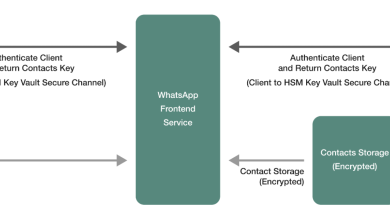Google Ads Discovery Campaigns: In-Depth Guide For 2024
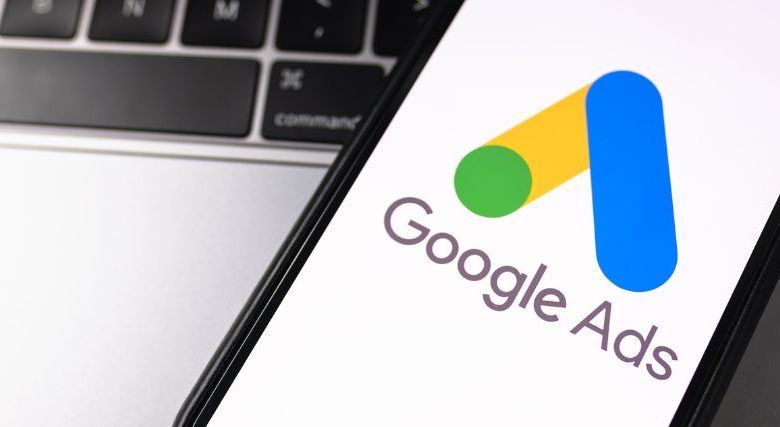
If you’re not using Google Ads discovery campaigns in your marketing strategy yet, you could be missing out. Widely regarded as one of the most powerful tools in the PPC advertising landscape, Google discovery campaigns are powerful tools for scaling conversions, reaching new customers, and reconnecting with previous consumers.
Google’s discovery campaign ads are visually engaging, highly personalized advertisements that appear throughout Google’s feeds on YouTube, Gmail, and the Google app. They’re meant to connect with audiences at the precise moment when they’re ready to “discover” new services and products.
Although these ad options aren’t entirely new (they’ve been available for a couple of years), they have grown more popular in recent years. Discovery campaigns can help organizations target specific demographics and provide companies with a unique way to deliver personalized experiences.
Let’s explore how Google Ad Discovery campaigns work and how you can use them to boost your business this year.
What are Google Ads Discovery Campaigns?
Otherwise known as “Google Discovery ads,” Google Discovery campaigns are personalized advertisements shown to audiences through a number of platforms in the Google ecosystem. They were announced in 2019 and made widely available a year later, in 2020.
According to Google, Discovery campaign ads use customer intent signals and machine learning algorithms to determine when users are most likely to engage with a brand.
One unique thing about these ads is they combine the features of high-intent search engine marketing with awareness-focused display campaigns. Unlike ad campaigns focused exclusively on promoting brand awareness at the top of the funnel, Discovery Campaigns offer companies an opportunity to reach customers with a high level of purchasing intent.
At the same time, Discovery campaigns provide businesses with a chance to customize their messages to different audience members. This leads to a higher level of engagement and an improved chance of conversions from your target audience. Discover campaigns can:
- Help you find new customers with a single ad campaign capable of reaching users across the YouTube Home and Watch Next Feeds, Google Discover app, and Gmail promotions.
- Leverage Google’s innovative customer intent algorithm to target audiences who have already expressed interest in a specific niche or product.
- Generate attention with eye-catching visual ads presented in a native format for the channel the target audience is using.
- Deliver consistent experiences with machine learning solutions that allow for seamless creative exposure across Google properties.
- Improve control over reach and frequency goals with automated bidding structures.
Different Types of Discovery Campaign Ads and Ad Formats
Google Ads discovery campaigns are shown across multiple different platforms within the Google ecosystem to boost your chances of extended reach. There are two core “ad format” options for Google Discovery Ads:
- Standard Discovery Ads = A single static image with a description and headline
- Discovery carousel ads: Multiple images with their own headlines and descriptions. This ad appears in a carousel format so users can scroll through each piece of content.
Both ad types will require you to upload multiple headlines, descriptions, and images because Google uses the content you provide interchangeably, depending on the audience. With AI, Google can determine which combination of content is most likely to engage and convert the person seeing it.
There are various styles of Google Discovery Ads for YouTube, Gmail, and Google Discover.
YouTube
Discovery Ads on YouTube can appear as in-feed video ads or “Watch Next” promotions. They appear in the form of image thumbnails, with a brief headline and description, alongside the business name and logo placed alongside the ad icon.
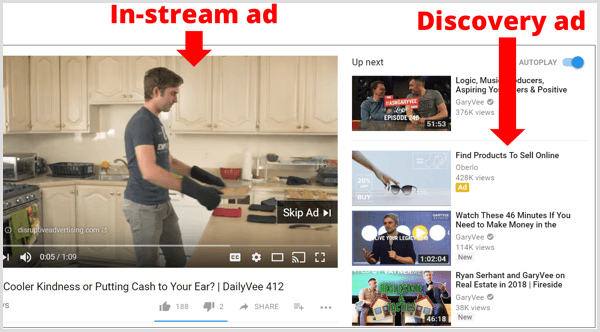
These discovery campaigns will appear at the top of the page when customers are browsing through the available videos related to their keywords. However, if you choose the “watch page” option for your display, they can appear anywhere in a list of related videos.
Gmail
Discovery ads can also appear on the Gmail app. They’re often strategically placed in the Gmail feed, underneath the “Social” tab in an inbox.

As users scroll through their inbox on Gmail, they’ll notice “Ad” icons in green, displayed alongside the subject line for the content. Clicking on these icons will allow the user to visit the landing page connected to the ad.
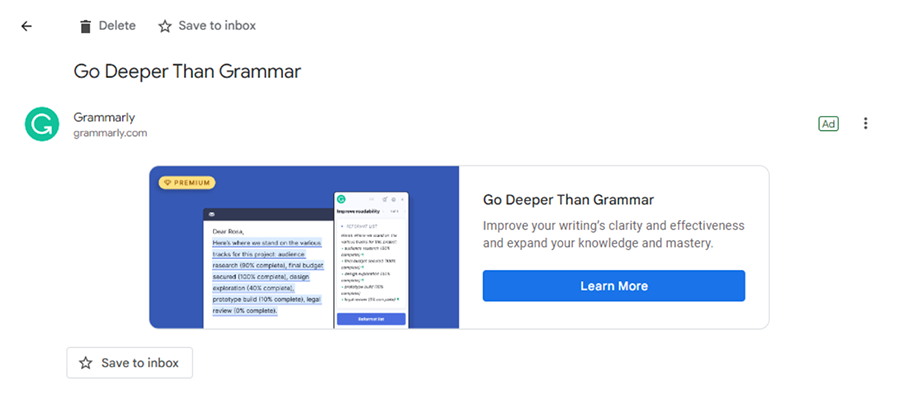
Google App and Discover feed
Individuals using the Google app on their smartphone or mobile device can also see Display ads showcased on the homepage, as well as the “Discover” feed. These ads are positioned within the Discover feed based on the interests of the target user.

While YouTube ads are excellent for engaging customers with video content when they’re searching for valuable information or guidance, Gmail ads are ideal for boosting brand awareness and clicks. Google Discover feed and app ads help to promote brand recognition and reach.
How to Get Started With Google Ads Discovery Campaigns
Getting started with Google Ads Discovery campaigns is relatively straightforward. Before you get started, it’s a good idea to set up conversion tracking within Google Ads. You can learn how to use Tag Manager to deploy conversion tracking strategies here.
Implementing conversion tracking will ensure you can determine exactly what kind of results each of your Discovery campaigns is having on your revenue and results.
Once you’ve done that, log into your Google Ads account to start creating your Discovery Ad. Click on the “New Campaign” button. When Google asks for your “Main Advertising Goal,” click on “Get more website sales or leads.”
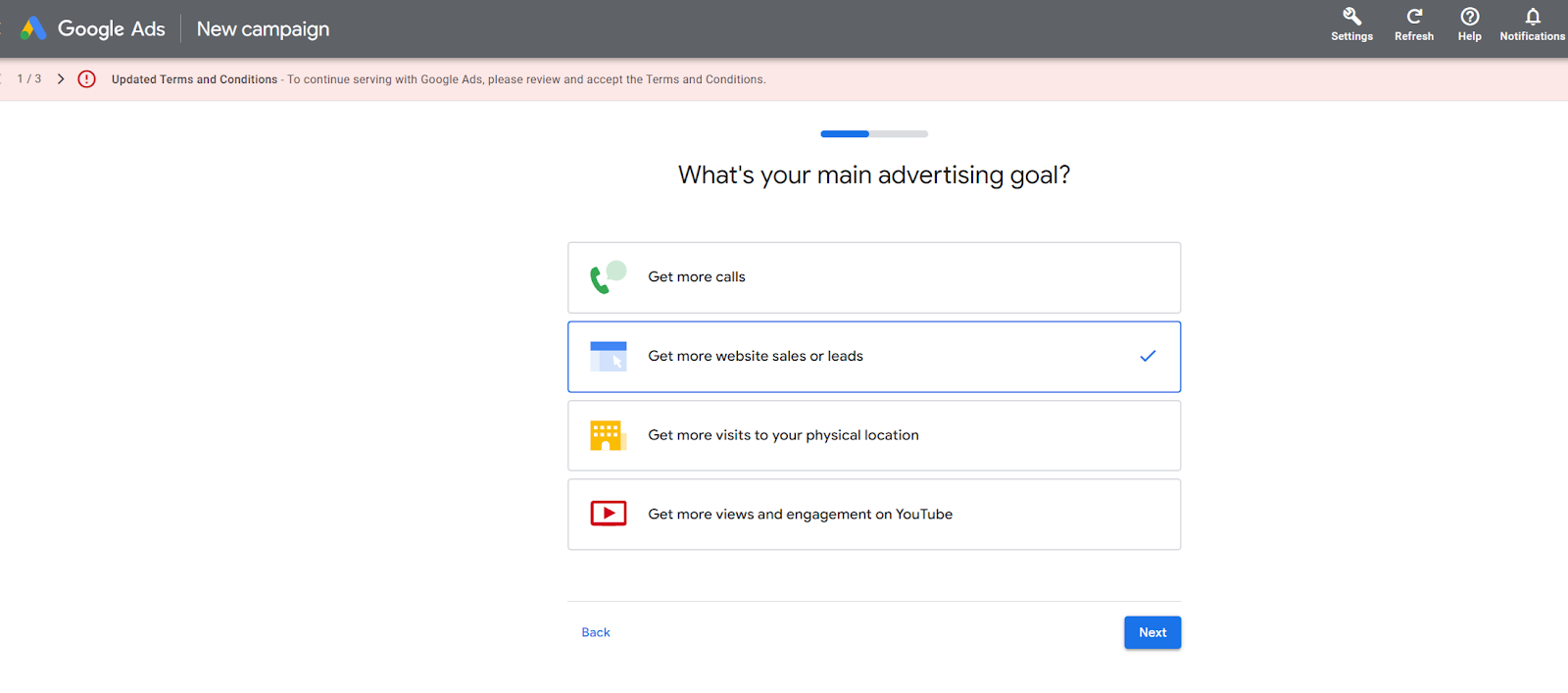
Next, click on “Discovery” in the section on Google Ads that asks you what kind of campaign type you want to use.
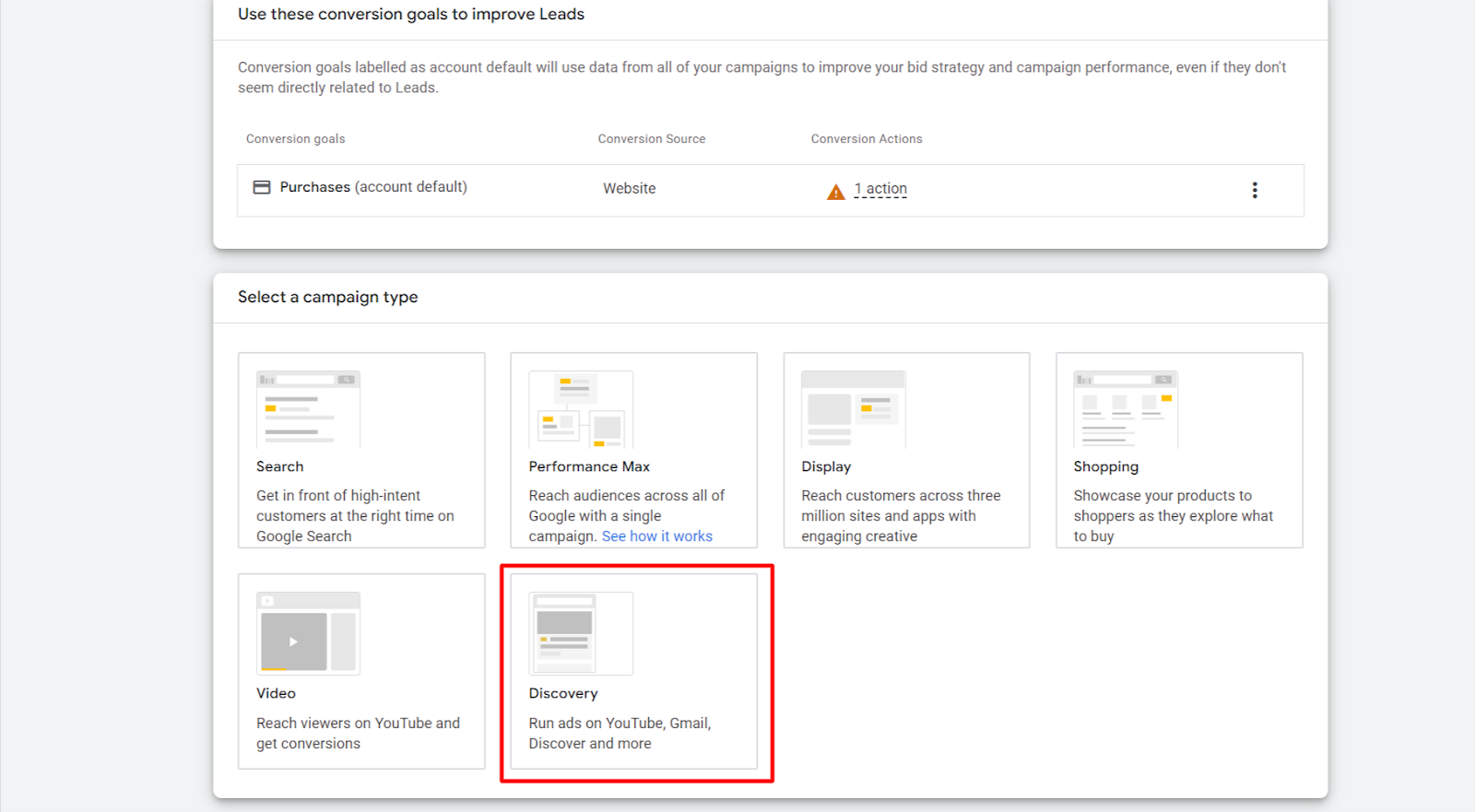
Next, enter the name of your company and the URL or page you want people to be directed to when they click on your ad. You can also give your discovery ad campaign a name.
You’ll be taken to a page where you can set a location for your campaign, as well as the language you want to use in your ads. Make sure you’re focusing on the specific customers you want to target in your chosen region.
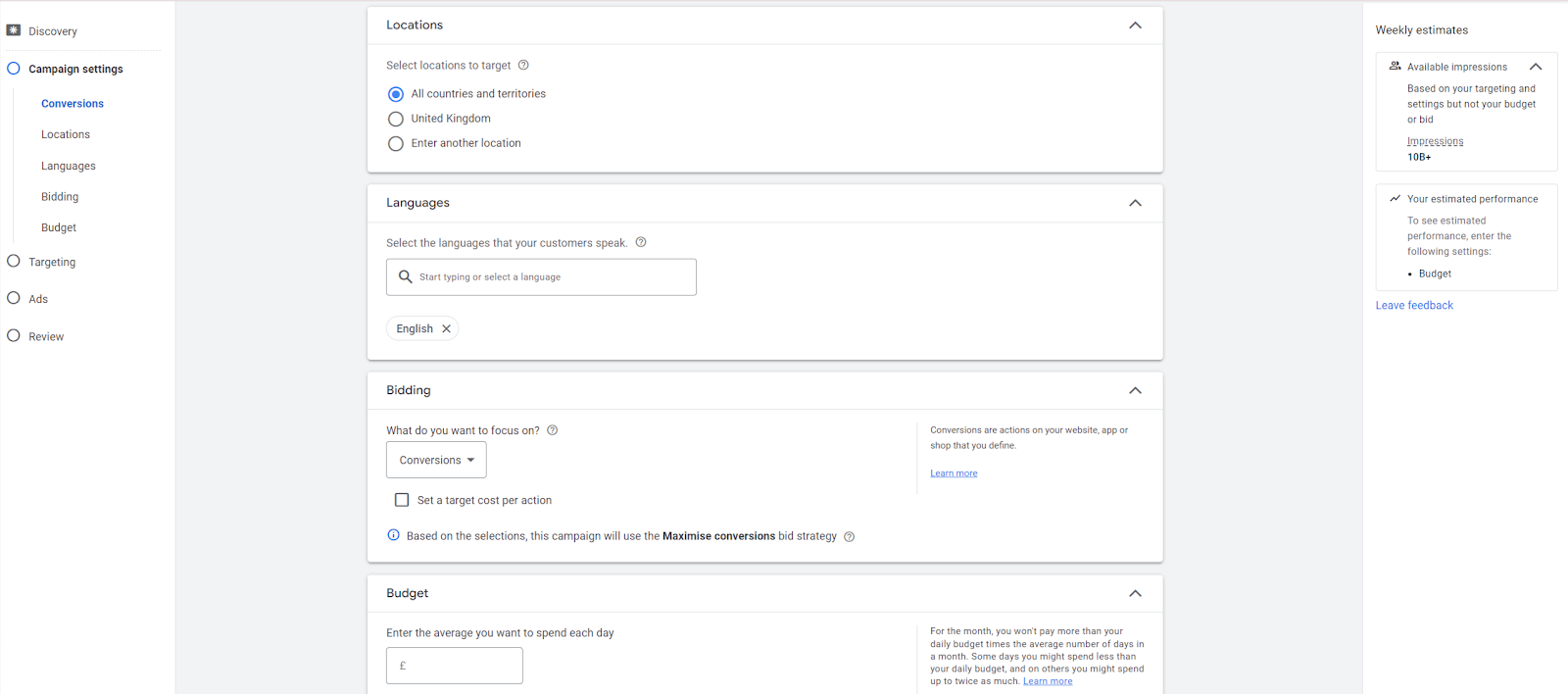
On this page, you’ll also be able to select your bidding structure. You can choose from a variety of Smart Bidding strategies, such as “Target CPA” and “Maximize Conversions.” Alternatively, you can simply enter the exact budget number in the box, which asks for the average amount you want to spend each day.
We’d recommend using a monthly rather than daily budget for your campaigns to help you. Simply divide the number you want to spend each month by 30 to enter the right number into the box.
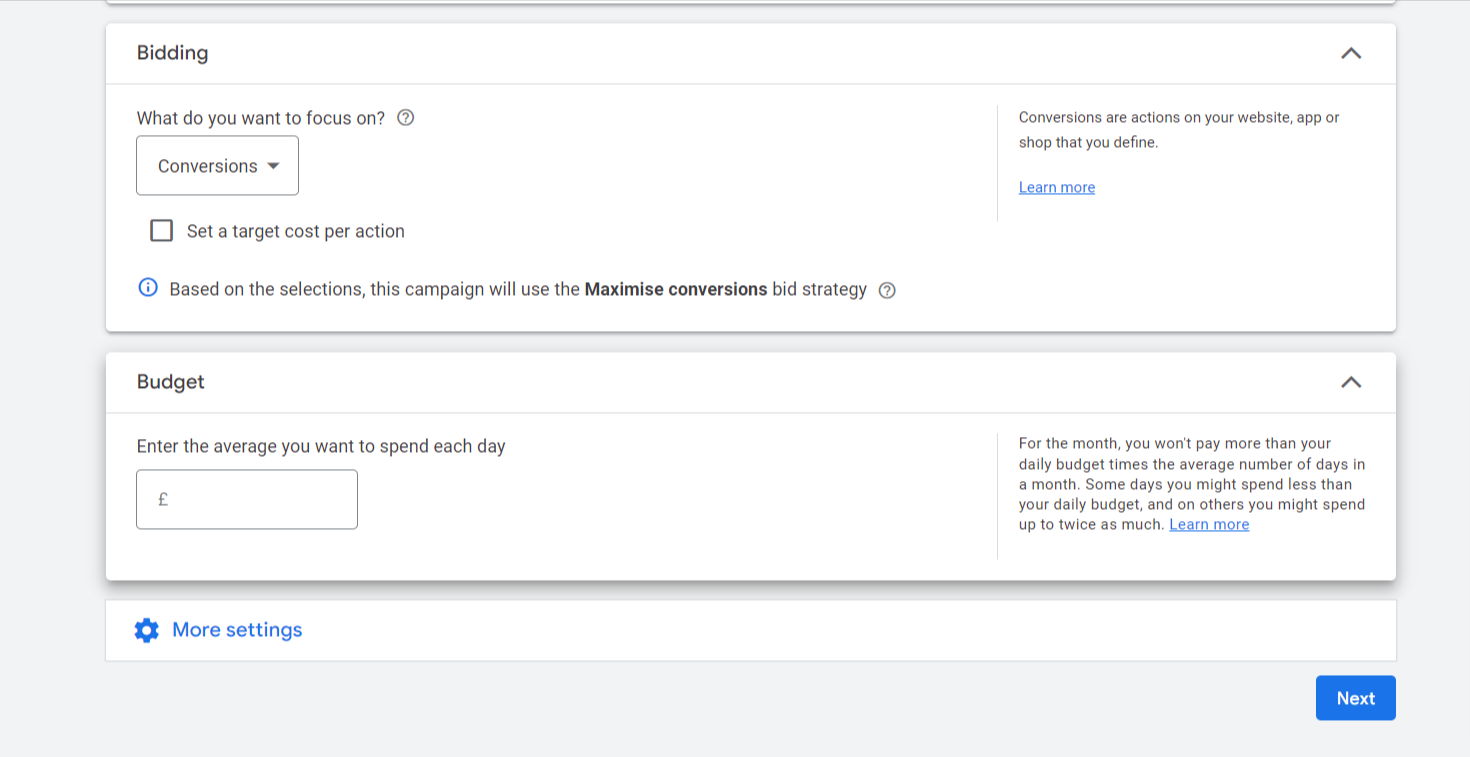
Once you’ve entered your budget, click on the “More Settings” tab to customize the additional settings for your campaign. You can set up an ad schedule (When you want your campaigns to run). Plus, you can set start and end dates for your campaign. You’ll also be able to implement campaign URL options and determine whether you want to avoid having your ad show on certain sites.

Next, you’ll move into the “Targeting” section for your campaign. This is where you can determine the audience you want to reach with your Discovery Campaign ads. You’ll be able to create an audience specific to your needs, focusing on different options such as:
- Demographics
- Detailed demographics
- Affinity audiences
- Life events
- Custom intent audiences
- In-market audiences
- Similar Audiences
- Remarketing audiences
You can also exclude certain audience members you don’t want to reach.

After building your audience, you can move on to creating your ads. You’ll be able to choose between either a standard Discovery ad or a carousel ad. Crucially, you will need to upload multiple descriptions, titles, and images for each of your Google Ads Discovery campaigns. This will ensure Google can serve the right content to each audience member to boost your results.

Once you’re happy with your campaign, you can review it in the final stage of the ad creation process and publish it. Remember, you should be constantly testing your ads. Use different targeting options, and create multiple discovery ads in each group to see what works best.
You may also want to create a range of different landing pages for your campaigns too. The more you test, the more you’ll be able to optimize your ad budget.
5 Best Practices for Discovery Campaigns
While setting up and launching your Google discovery campaigns is relatively straightforward, there are still some key steps you’ll need to take if you want to improve your chances of success. Here are some of the best ways to improve the performance of your discovery campaign ads:
1. Define your budget and audience carefully
There are many factors that can determine whether your Google Ads discovery campaigns turn out to be a success or not. However, few things are more important to your results than choosing the right budget and target audience. While it might be tempting to start relatively low with your budget, you may need to invest a little more if you want to stand out from the competition.
Consider using the suggestions made by Google to guide your ad strategy, or think about working with a Google ads optimization expert. Choose your audience with caution too. Think carefully about exactly who you want to reach, and consider combining multiple demographic factors to create a highly unique “target audience.” You can always experiment with your audience at a later stage to see whether tweaks lead to more conversions.
2. Don’t make changes too quickly
One point to note when you’re creating Google Ads discovery campaigns is they can take a little time to deliver significant results. Google Discovery ads rely heavily on the use of machine learning and built-in optimization algorithms to present ads to the right people at the correct time.
Unless something in your ad is clearly broken or not working as it’s supposed to, it’s best to leave the campaign alone so it can gather as much data as possible. Remember, smart and automated bidding strategies also need some time to settle down and adhere to the guidelines you’ve set. Wait a couple of weeks before you review.
3. Use high-quality images
This might seem like obvious advice, but it’s something you shouldn’t overlook. If you want your campaigns to stand out on YouTube and other platforms, you need to ensure they can capture the audience’s attention with the right visuals. Avoid any blurry or low-quality images, and make sure you showcase your unique brand personality wherever possible.
It’s a good idea to stick with clean, simple backgrounds, so your products can collect the most attention. You should also avoid adding too much text to your images. Too much text within your ad creative could mean it’s rejected by Google.
4. Optimize Your Messaging
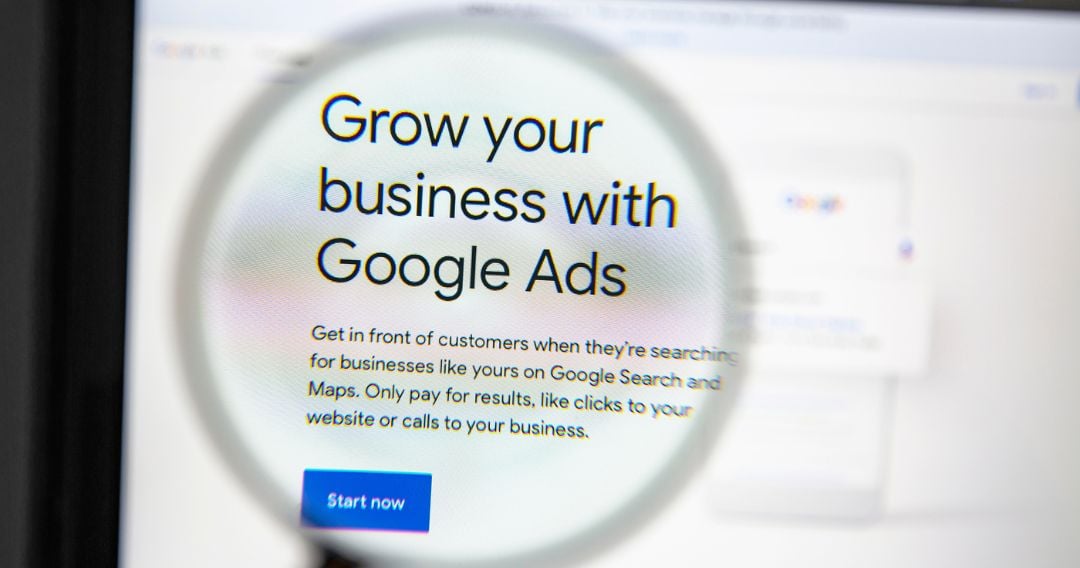
Google Ads discovery campaigns work best when they combine the right copy with the most eye-catching and engaging images. Your ad creative needs to be compelling enough to convince customers they want to click on your ad and learn more about your business. Fill out all of the description and headline sections carefully.
Think about how you can use power words to attract and convert your customers. Experiment with different styles of messaging, and always focus on highlighting the benefits of your offer. A/B test your ad campaigns to make sure you’re using the text most likely to generate results.
5. Be Wary of Automated Targeting
While using automated targeting in your ad groups can seem like an excellent way to save some extra time and money, it can also cause major problems. Sometimes, the best option is to eliminate “optimized targeting” entirely, so you can focus on directing your ads specifically to the user groups and ideal customers you’ve detected.
Automatic targeting can also cause issues if you’re using Discovery campaigns to retarget existing customers, as it could cause Google to send remarketing campaigns to people who have never actually interacted with your business.
FAQ
What is the difference between discovery ads and display ads?
The main difference between discovery ads and display ads is who they’re targeting and where they’re reaching your audience. Discovery ads focus on people exhibiting high-intent behavior, while display ads can appear for a wide range of different customers. Google Discovery ads also appear on Google feeds, while display ads appear on the Google Display Network.
Are discovery ads effective?
Discovery ads can be an excellent way for companies to scale their conversions and reach new customers with a high level of purchasing intent. They’re also ideal for when you want to reconnect with previous customers and encourage them to buy something again.
Which is better: Search Ads or Discovery Ads?
There’s no one-size-fits-all answer here. Search ads typically drive more awareness than some discovery ads because they can reach a wider audience. However, Discovery ads can be great for increasing conversions because they focus on high-intent prospects.
Using Google Ads Discovery Campaigns to Your Advantage
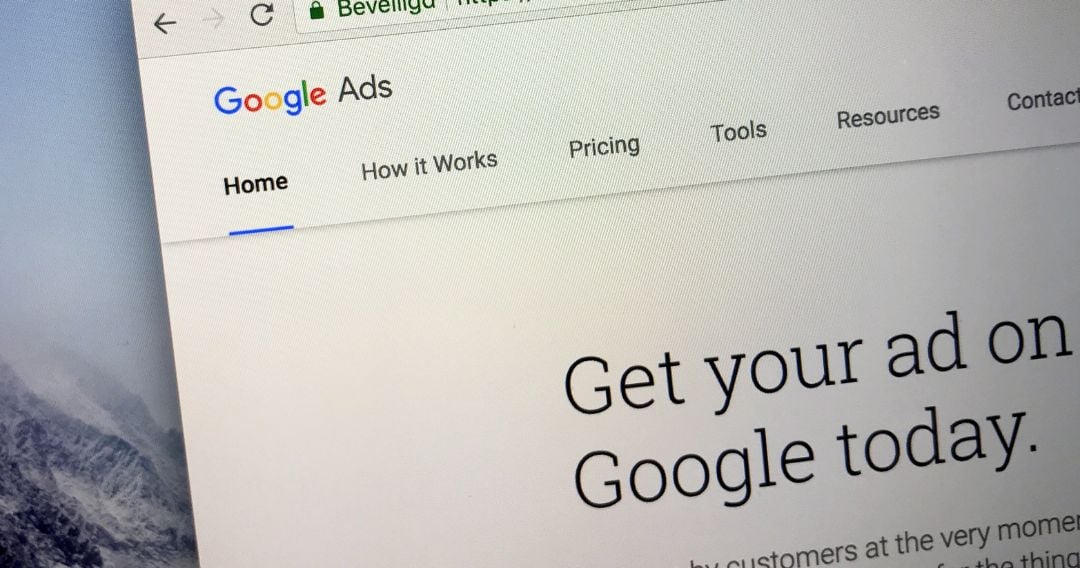
Used correctly, Google Ads Discovery campaigns can be an excellent way to improve conversions and boost brand awareness. They position your company in front of high-intent customers and target prospects with personalized, highly engaging, and algorithmic campaigns.
Experimenting with Discovery campaigns can be a great way to take your organization’s paid marketing strategy to the next level. However, if you’re struggling with creating ad copy, increasing conversions, or choosing the right budget, you might find it helpful to access some additional support. Google Ads experts from Toptal can help you build and use the best possible Google ad campaigns for your business.
Reach out today to learn more.



